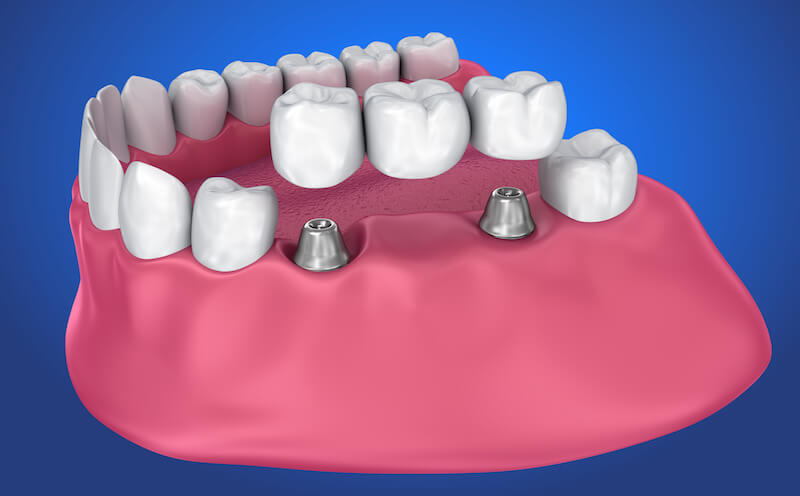
If you have one or more missing teeth, a dental bridge may be recommended. Moving teeth can cause changes in your bite as well as the loss of additional teeth, decay and gum disease.
At Langley Dental Centre, we provide dental bridges to help keep your remaining teeth from drifting out of position. The dental bridge, made of a grouping of interconnected crowns, is designed to fit your mouth, replacing the missing teeth while supporting those that remain. It is held in place by two crowns.
You can reduce your risk of gum disease, help correct bite issues, and improve speech with a dental bridge. Contact Langley Dental Centre in Langley to discuss your bridge options. For more information on bridges, visit the Canadian Dental Association.
The Benefits Dental Bridges
A dental bridge spans the gap where a missing tooth once was, filling the space with a synthetic tooth. Like a bridge over a river, most dental bridges need support at either end, although cantilever bridges are an exception. Fitting a bridge requires reshaping the abutment teeth and capping them with crowns to hold the bridge securely.
Who Needs Dental Bridges?
Anyone who has missing or damaged teeth may be a candidate for dental bridges. Without something to occupy gaps, the remaining teeth can shift position and alter your bite. These changes can lead to jaw pain, headaches and an increased risk of periodontal disease. Bridgework is more than a cosmetic procedure; it is essential to dental health. Bridges serve a number of purposes:
- Restoring a healthy bite to facilitate chewing
- Maintaining the contours of the face
- Improving your smile
- Reducing damage to remaining teeth from a misaligned bite
- Restoring self-confidence after an accident or injury
- Materials for Dental Bridges
Materials for Dental Bridges
Creating dental bridges is both a science and an art. The bridgework must feel functional and natural, and it must also match your natural teeth. To mimic the look of natural enamel, dentists may use zirconia or porcelain fused to metal.
Getting a Dental Bridge
Your dentist will schedule two appointments for creating and fitting your bridge. During your first visit, the dentist will give you a local anesthetic and prepare the abutment teeth for the appliance. After shaping the neighboring teeth, the dentist will take a bite impression. This impression will become the mold for the bridge’s structure. You will then get a temporary bridge and crowns to protect the abutment teeth while your permanent bridge is being made.
During your subsequent dental appointment, you will have your permanent bridge fitted and shaped. If it is a fixed bridge, the dentist will attach it to the abutment teeth. For removable bridges, metal or plastic clasps are affixed to the abutment teeth to hold the appliance.
Caring for Dental Bridges
Bridgework must be cleaned diligently, and that requires adding a few new tools to your oral hygiene regimen. A dental floss threader lets you sweep under your bridgework to keep the area clean. Small, flexible brushes can also be handy. Water jet devices blast trapped food particles from beneath bridgework. Your dentist can recommend oral care products to care for your porcelain or resin bridge.
Removable bridges require gentle handling. Porcelain is a brittle substance and can chip if treated roughly. Set your bridge down carefully instead of dropping it onto hard surfaces. Removable bridgework should be cleaned as often as you clean your other teeth and can be brushed with the same toothpaste or with cleansers designed for dentures.
Follow any specific instructions for the care of your bridgework and tell your dentist if you note any of the following concerns that could indicate a bridge that no longer fits:
- Difficulty biting or chewing your food
- Headaches or jaw pain
- Loosening of removable bridgework
- Rough or raw spots on the soft tissues surrounding the bridge
- Difficulty speaking clearly

